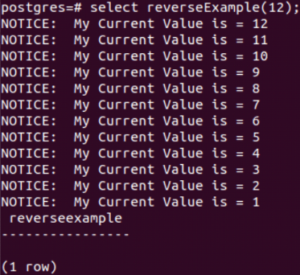

By default, the for loop adds the step to the loopcounter after each iteration. drop function ProcessReward () CREATE OR REPLACE FUNCTION ProcessReward () RETURNS text AS DECLARE sessionid NO SCROLL CURSOR FOR SELECT pg.'Setting',pg.'UserId',pg.'Id' FROM 'Development'.'PersonGame' pg inner join 'Development'.'Game' g on g.'Id' pg.'GameId' pg.'GameId'1 for read only titles TEXT DEFAULT '' rec record jsonrec record. (case_id, activity, lifecycle, time_stamp) In this syntax: First, the for loop creates an integer variable loopcounter which is accessible inside the loop only. VALUES (',rec_tbls.hadm_id,',''',tbl_column,''',''',life_cycle,''',',rec_tbls.tbl_column,') ') ĮRROR: record "rec_tbls" has no field "tbl_column"ĬONTEXT: SQL statement "SELECT concat('INSERT INTO EventLog_Main Tx :=concat('INSERT INTO EventLog_Main (case_id, activity, lifecycle, time_stamp) OPEN csr_innner_create_evnt_log FOR EXECUTE sql_eventlog_stge_rows įETCH csr_innner_create_evnt_log INTO tbl_name, tbl_column, col_datatype, event_role, life_cycle OPEN csr_outer_create_evnt_log FOR EXECUTE sql_table_rows įETCH csr_outer_create_evnt_log INTO rec_tbls
#Postgresql for loop cursor update#
Then in the loop, select the now-current v from the table based on the pk (rather than current of main ), and update it using the pk. An implicit cursor FOR loop has a SELECT statement querying a table or a view instead of lower bound and upper bound values in the case of the traditional. Set_SrchPath := concat('SET search_path TO ',schem_name,' ') Make the cursor be WITH HOLD, but select the pk rather than v.

Setting the search path to the specified db schema For example: CREATE PROCEDURE p () BEGIN DECLARE counter INT DEFAULT 0 FOR SELECT a, b FROM t DO SET counter counter + 1 END FOR. Sql_table_rows text := 'Select * from admissions ' Sql_eventlog_stge_rows text := 'SELECT tablename, columnname, datatype, eventrole, lifecycle
#Postgresql for loop cursor code#
CURSOR CODE BLOCK TO CREATE AN EVENT LOG DOĬsr_outer_create_evnt_log REFCURSOR -Cursor to get the data from the main tableĬsr_innner_create_evnt_log REFCURSOR -Cursor to dissect each row of the main table The different uses of the for loop in PostgreSQL are described below: 1. The problem is, I am passing the value of a column from the returned record from the first cursor but my INSERT statement is not recognizing it. Courses Practice PostgreSQL provides the for loop statements to iterate over a range of integers or over a result set or over the result set of a dynamic query. After evaluating each row, I insert the result to a table ( EventLog_Main). A position within a result set is indicated by a cursor. My plan is to get rows of data from a table ( Admissions) using the "outer cursor" and evaluating each row using criteria from another table ( EventLog_Staging). A cursor, however, enables you to fetch the result rows one at a time.

Use cursors only when you really really need it.I need help with my " postgresql nested cursors" code. SQL can process very well massive operations. The most fast and most effective is command: INSERT INTO newtbl SELECT studentId FROM student_list The right way to do it would be: 'dontt iterate'. Important things - PostgreSQL has not tabular variables - so you cannot to assign more rows to one variable, and you cannot to fill more rows from one variable.īut your request looks like premature optimization.

So FOR IN EXECUTE FETCH is reading via cursor from another cursor, what is performance nonsense and it really ugly code. Postgresql cursor, at least in 8.1, is very slow with a DML operation, such as UPDATE or INSERT (havent tested DELETE, yet assume it would be the same). by default, and is nonsense use FETCH 2x The reason for that is postgresql 8.1 is the last implemented and supported version of this language by ParAccel. iteration over FETCH is possible only via This code should to work, but it is crazy.Ĭ cursor for select * from generate_series(1,100) INSERT INTO new_tbl SELECT myrow.student_id CREATE OR REPLACE FUNCTION loop_fetch()Ĭur1 CURSOR FOR SELECT * FROM student_list The following code is little bit strange, and I write it here only for education - don't think so it has any benefit for practical life. If you want to use cursors explicitly (and really you want to fetch in block), you need to use more cycles. This statement uses cursors internally, and it fetch 10 rows in first iteration, and 50 in other iterations. The short and probably most correct solution is using FOR IN SELECT. I got a error: ERROR: FETCH statement cannot return multiple rows MyRow is composite variable - it can hold only one row. FETCH NEXT 10 takes 10 rows from cursor, but INTO clause takes only first and other are lost.


 0 kommentar(er)
0 kommentar(er)
